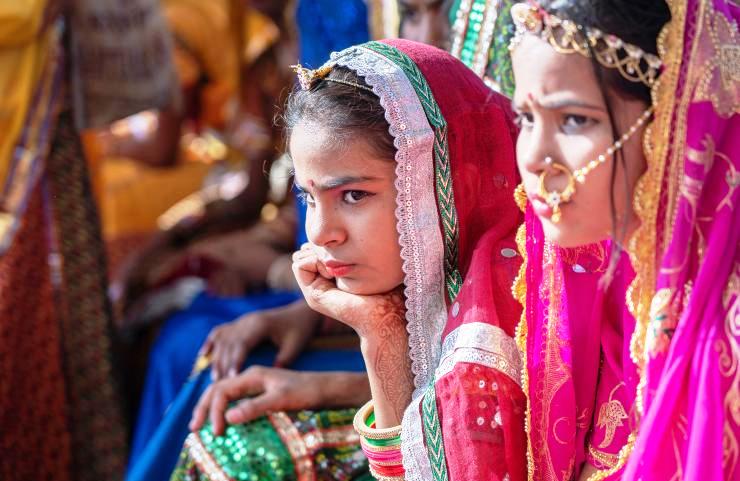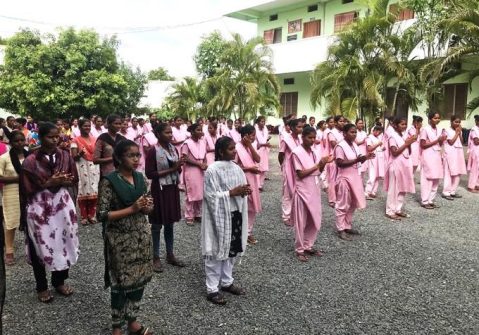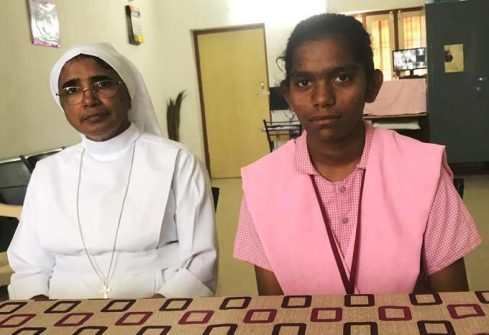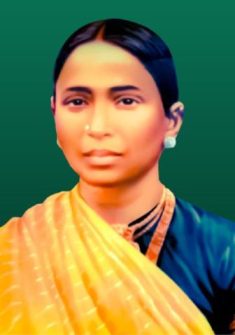India. Child Brides. A School for a Fresh Start.

According to a recent UNICEF report, there are 640 million, 200 million in India alone, child brides. In Polur – in Andhra Pradesh – a congregation of nuns runs the ‘Sree Jeevan Jyothi Vocational Junior College’, a nursing school that welcomes young women who are victims of early marriage
Kavitha and Navyashree, are two Indian girls who were married off at the ages of 14 and 16. Their marriage didn’t last long; they were in fact chased out of their homes by their in-laws in a village in the state of Andhra Pradesh, in south-eastern India.
Today they live in Polur – in the Nandyal district – together with 150 other young women in the ‘Sree Jeevan Jyothi Vocational Junior College’, an institute that since 2010 has welcomed girls – many of whom are victims of early marriages – and prepares them to become nurses so that they can care for the elderly, pregnant women and disabled people both at home and in hospitals. The institute is run by the nuns of the Society of Saint Anna Phirangipuram – a local congregation dating back to 1874 – and aims to take care of child brides and girls in extreme poverty and make them independent.

The students of the Sree Jeevan Jyothi Vocational Junior College attend the morning assembly in Polur, a village in the southeastern Indian state of Andhra Pradesh. (GSR photo/Thomas Scaria)
In India, marriage under the age of 18 is prohibited; but at the beginning of the year over 1,800 men were arrested, mainly in the north-east of the country, in 4,000 cases of child marriage. This practice, unfortunately, is still widespread not only in India but throughout the world. And indeed, it has grown again as a consequence of the Coronavirus pandemic.
The new UNICEF report ‘Is an End to Child Marriage within Reach? Latest Trends and Future 2023 Prospects Update’ highlights that 640 million girls are married off worldwide, 12 million every year. And India alone has a third of them, or a number of child brides that exceeds 200 million. Furthermore, it is estimated that another 10 million girls will become child brides by 2030 due to the effects of the pandemic. In fact, as we read in the report, across the world, conflicts, climate disasters and the ongoing impact of Covid-19 – in particular the increase in poverty, income shocks and school dropout – contribute to increase the causes of child marriage and make it difficult for girls to access the health care, education, social services, and community support that protect them from child marriage.

Kavitha talks about her early marriage and separation with Sr. Ignatius Suman, the director of the College. (GSR photo/Thomas Scaria)
Kavihta is now 18 years old and has spoken of how she was forced by her parents to marry a stranger shortly after eighth grade. At her husband’s house, she had to do household chores, get up at two in the morning, cook for the family of six and then go to work on the farm all day under the scorching sun. She was very often beaten by her husband and her parents for her shortcomings in her work. “One day I attempted suicide, and they kicked me out”, she said.
It was Sister Balajyothi Ramisetti who found her and admitted her to nursing school. “We have several cases like hers among our students; they gradually emerge from the trauma and manage to study well”, she says.Navyashree – now 26 and a first-year junior college student – has been married to a close relative for seven years. “I had four pregnancies, including two miscarriages; the other two children were born mentally retarded and were unable to survive”, she says. “My husband’s family blamed me for my inability to give birth to healthy children and they sent me away”. Consanguineous marriages are very common in the villages of Andhra Pradesh and lead to the birth of unhealthy children who often die very early.To prevent dropping out, and to work on their personality development, female students stay in the hostel attached to the College and during their stay on campus they keep busy with various activities, such as tailoring courses, cooking exercises, cultural events, and sports and counselling sessions that help them overcome their traumatic past.
Since its opening, the school has trained 650 young women and also holds courses for laboratory technicians. The government’s Board of Intermediate Education has recognized the College making it an accredited school.

Thatipatri Gnanamma (1822 – 1874) founded the congregation of Sisters of St. Anne of Madras and Sisters of St. Anne Phirangipuram.
The congregation was founded by Thatipatri Gnanamma to educate and promote women, especially those living in rural areas, who are particularly vulnerable and often victims of unjust systems and traditions. Thatipatri Gnanamma was an ordinary lay woman from Phirangipuram, a small village in Guntur district, Andhra Pradesh. She was married to Innaiah and had five children. Unfortunately, she was widowed at the age of 37. Four of her children entered religious life and one married. Finally free from all family commitments, Gnanamma moved to a village called Kilacheri, 40 km from Chennai, where she lived until her death. In her time, girls’ education was an impossible dream. Gnanamma constantly kept in touch with the illiterate girls in the area and identified education as the main means of making them independent. Father Arokianathar, the parish priest of Kilacheri, helped her to think concretely and establish a school for girls in Kilacheri in 1863. Inspired by her commitment to serving the cause of women, two young girls asked Gnanamma if they could help in this inspiring work, also expressing the desire to become nuns. Gnanamma agreed and sent them to Bellary for training. After initial training, these two girls became nuns and thus a religious congregation known as the ‘Society of Sisters of St. Anne-Madras’ (SSAM) was born, with the specific vision of giving impetus to the cause of women.
In 1999, Pope John Paul II established it as a pontifical congregation and it now has more than 1,000 members in 90 convents, serving in five continents. (Open Photo: 123rf)
Sara Toffano/MM



